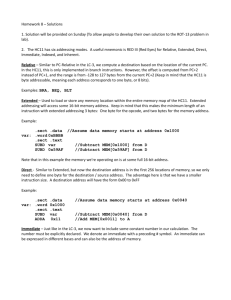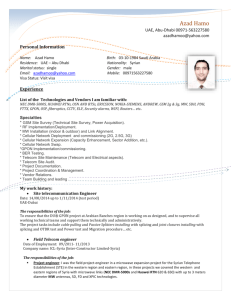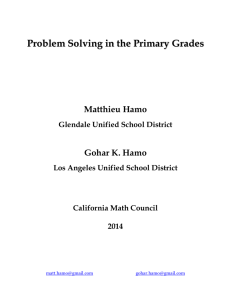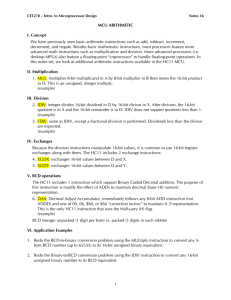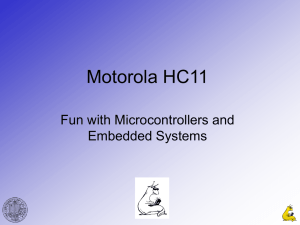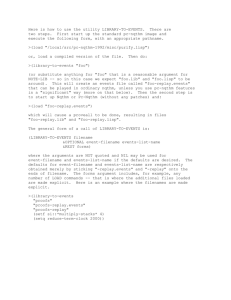Welcome to CMPE 12C
advertisement
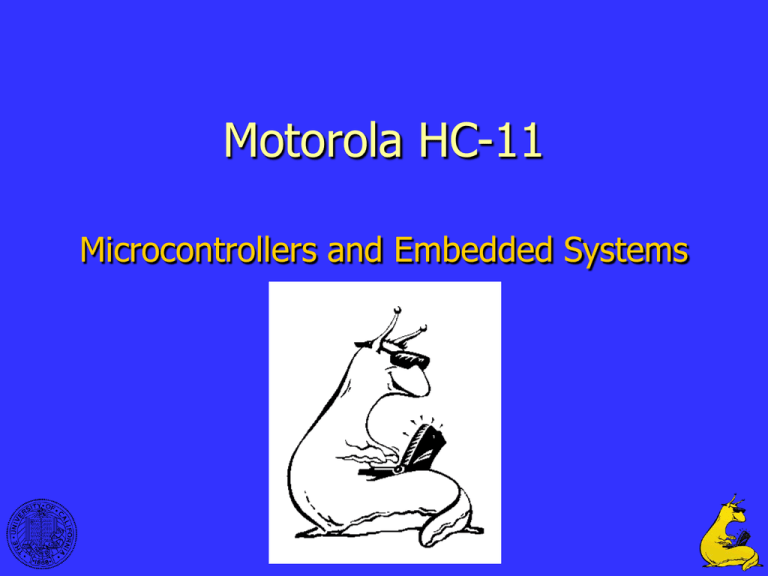
Motorola HC-11
Microcontrollers and Embedded Systems
1
What is a microcontroller?
• A microprocessor
– Usually not cutting edge
– Dependable
• All major bugs well known
– Predictable
• Critical for real-time processing
• On-chip peripherals and memory
– Parallel and serial digital I/O
– Analog I/O
– Counters and timers
• Internal ROM and/or EPROM
2
Microcontrollers
What are microcontrollers used in?
• Watches
• Microwaves
• Stereo Receivers
• ATMs
• PDA’s, MP3 players
• Automobiles
Some products that you might know:
•
•
•
•
•
•
NASA’s Sojourner Rover – 8-bit Intel 80C85
Palm Vx handheld – 32-bit Motorola Dragonball EZ
Sonicare toothbrush – 8-bit Zilog Z8
The Vendo V-MAX 720 Soda Machine – Motorola HC11
Miele dishwasher – 8-bit Motorola 68HC05
Hunter 44550 Programmable Thermostat – (4-bit cpu)
3
Microcontrollers
Microcontroller unit sales are 15x higher than
microprocessors.
… and are MUCH,
MUCH cheaper.
4
Microcontrollers
Microcontroller Markets
• Microcontrollers
are a large
market
• 8-bit controllers
are the largest,
but not growing
the fastest.
5
Microcontrollers
• 8-bit microcontroller growth rate for 2003 is at
9.42%.
• Microcontroller growth rate in general is 11.5%.
• 8-bit controllers loosing market share in 2003.
Was 62.36% in 1998 down to 56.76% in 2003.
Source: Cahners In-Stat Group
6
Microcontrollers
• 16- and 32-bit and higher are on the rise.
They will double their unit market share from
15.11% in 1998 up to 31.56% in 2003,
decreasing 4-bit and 8-bit devices.
• But, in 2003, the 8-bit microcontrollers will
outnumber the higher bit units by almost 80%
in the market place.
Source: Cahners In-Stat Group
7
Microcontrollers
So what languages are they being programmed
in?
Language
‘98-’99
‘99-’00
Assembly
~ 21%
~ 10%
C
~ 69%
~ 80%
C++
~ 5%
~ 6%
Java
~1%
~ 2%
Other
~3%
~ 2%
Source: TRON Association Survey 1998/99 & 1999/2000
8
Motorola M68HC11
• M6801 CPU core
• ROM (8KB), EEPROM (512B), RAM (256B)
– Counter/Timer system
– A/D converter
• D/A in kit
• Parallel I/O
• Serial I/O (SPI and SCI)
• Expansion bus
– To add more memory
9
HC11
HC11 Architecture
10
M8601 CPU Core
•
•
•
•
•
•
•
•
•
•
8-bit
CISC
Accumulator-based
Results wind up in a 8-bit accumulator A or B
16-bit results go to accumulator AB, called D
Two index registers for addressing memory or for counting - X and Y
Dedicated stack pointer
Push and Pop instructions use this – grows toward smaller memory
addresses like in LC-3
Program Counter
Condition Codes
11
Check out the lab manual
• It is online on the class website
• Contains a section on the HC11
• It is a great reference
Also get the programmer reference guide,
free at BELS (basement of BE)
12
M8601 CPU Core
ALU – Arithmetic Logic Unit
13
HC11 Microcontroller
14
HC11 Microcontroller
Condition Codes
• More present then in LC-3
• Single-bit flags set appropriately for most instructions
(several instructions do not, including push and pop)
C
V
Z
N
H
Carry/Borrow
Overflow
Zero
Negative
Half-Carry
15
HC11 Microcontroller
Example of how condition codes are used
HC11 code
What it does
cmpa #4
Subtract AccA - 4, set CCR
bge mylabel
Branch if
(CCR[Z]=1 OR CCR[N]=0)
16
HC11 Assembly Syntax
• Have separate sections for data declarations and
for instructions
– Use “.sect .data” for data sections
– Use “.sect .text” for instructions sections.
• Have more data types
–
–
–
–
–
“.space” for array declarations
“.byte” declares just a byte
“.word” declares 16-bits also
“.asciz” declares a string of characters
“.ascii” declares a string, no NULL terminator
• Comments use a “C++” style “//”
17
Data Declaration Examples
.sect .data
myvar:
.word
0x1000
// init a word
myarray: .space
20
// 20 entries
mychar:
.byte
‘a’
// a character
mybyte:
.byte
23
// DEC integer
myhi:
myhi2:
.asciz
.ascii
“Hi”
“Hi”
// a string
// a string
.sect .text
// Instructions would start here.
// Can have many .text and .data sections.
18
HC11 Microcontroller
Configuration Registers
Bits set by the user to tell the processor how to do
things
I
X
S
Interrupt Mask
XIRQ mask
Disable STOP instructions
19
Return to Addressing Modes
Addressing Modes:
LC-3 has:
• PC-Relative
• Base Displacement
• Indirect
HC11 has many:
• Check opcode listings to see what modes work
with what instructions
• Also check what condition codes are set
20
HC11 Addressing Modes
Supports these addressing modes:
•Immediate (IMM)
•Extended (EXT)
•Direct (DIR)
•Indexed (INDX and INDY)
•Inherent (INH)
•Relative (REL)
21
HC11 Addressing Modes
Immediate addressing
•1 or 2 byte immediate depending on register involved
(LDAA vs. LDD)
•ALWAYS include a #
•Several formats for different bases -- C-style
constants instead of what is in the HC11
manual (don’t use !,$,@,%)
•Decimal:
LDAA #245
•Hexadecimal:
LDAA #0x61
•Octal:
LDAA #041
•Binary:
LDAA #0b11000011
•ASCII:
LDAA #’a’
22
HC11 Addressing Modes
Extended and Direct addressing
•Access an absolute memory location
•Essentially the same mode, but with 8-bit (direct)
or 16-bit (enhanced or extended) addresses
•The assembler will decide on which to use based
on how many bits are needed
•Example
// Your data starts at address 0x4000:
.sect .data
var:
.word 0x1000 // Allocate/initialize a word
// Note: a word is 16 bits!
.sect .text
SUBD var
SUBD 0x4000
// Subtract [var] from D
// Subtract [var] from D
23
HC11 Addressing Modes
Indexed addressing
•Uses index register X or Y
•Similar to LC-3 “LDR R0, R2, #3”
•But can access memory and use it all at once!!
•Example
#define
ldx
addd
addd
addd
mydef 4
#var
0,X
2,X
mydef*2, X
//
//
//
//
//
//
c preprocessor used
Like LC-3 load address
add contents of M[0+X] to D
(Note “addd X” doesn’t work)
add contents of M[2+X] to D
add contents of M[8+X] to D
24
HC11 Addressing Modes
Inherent addressing
•Opcode fully specifies operation; no addressing
•Examples:
INCB increment accumulator B
ASLA Arithmetic Shift Left accumulator A
PSHY Push index register Y onto stack
25
HC11 Addressing Modes
Relative addressing
• Used for branches by the assembler
• Offsets from –128 to +128 bytes
• Use jumps for longer branches
26
HC11 Address Modes Review
ldab #0
// loads the number 0 into b
ldaa foo
// loads the contents of byte
// variable foo into “a” acc.
ldy #foo
// loads the address of foo into y
ldab 0, x
// loads the byte at address x+0
// into “b” acc.
ldx 0
// loads whatever is at memory
// address 0 into “x” index.
// You don't want this in 12c ever.
27
Motorola 68HC11 Instructions
• HC11 Instructions have variable lengths
– not like LC-3
• Careful coding can keep applications small and able
to fit in the EPROM
• We don’t have to worry about this since we’re using
Expansion Mode
– there is extra memory in the microkits.
• The opcode is always 1 byte
• An additional 0-3 bytes specify the data to work with
28
Motorola 68HC11 Instruction Set
• Accumulator and Memory Instructions
• Stack and Index Register Instructions
• Condition Code Register Instructions
• Program Control Instructions
29
HC11 Instructions
Accumulator and Memory
Instructions
Can be broken up into these 6 general types:
1. Loads, stores, and transfers
2. Arithmetic operations
3. Multiply and divide
4. Logical operations
5. Data testing and bit manipulation
6. Shifts and rotates
30
HC11 Instructions
Almost all MCU
activities involve
transferring data
from memories or
peripherals into the
CPU or transferring
results from the CPU
into memory or I/O
devices.
31
HC11 Instructions
This group of
instructions supports
arithmetic operations
on a variety of
operands; 8- and 16bit operations are
supported directly and
can easily be extended
to support multipleword operands. Twoscomplement (signed)
and binary (unsigned)
operations are
supported directly.
32
HC11 Instructions
Compare instructions
perform a subtract
within the CPU to
update the condition
code bits without
altering either
operand. Although
test instructions are
provided, they are
seldom needed since
almost all other
operations
automatically update
the condition code
bits.
33
HC11 Instructions
One multiply and two divide instructions are provided. The 8-bit by 8-bit
multiply produces a 16-bit result. The integer divide (IDIV) performs a
16-bit by 16-bit divide, producing a 16-bit result and a 16-bit remainder.
The fractional divide (FDIV) divides a 16-bit numerator by a larger 16-bit
denominator, producing a 16-bit result (a binary weighted fraction
between 0 and 0.99998) and a 16-bit remainder.
34
HC11 Instructions
This group of instructions is used to perform the Boolean logical
operations AND, inclusive OR, exclusive OR, and one’s complement.
35
HC11 Instructions
This group of instructions is used to operate on operands as small as a
single bit, but these instructions can also operate on any combination of
bits within any 8-bit location in the 64-Kbyte memory space.
36
HC11 Instructions
All the shift and rotate
functions in the
M68HC11 CPU involve
the carry bit in the CCR
in addition to the 8- or
16-bit operand in the
instruction, which
permits easy extension
to multiple-word
operands.
37
HC11 Instructions
Stack and Index Register
Instructions
38
HC11 Instructions
This table summarizes the
instructions available for
the 16-bit index registers
(X and Y) and the 16-bit
stack pointer.
39
HC11 System Stack
• The HC11 has a stack set up for us
• Memory is “byte” addressable
Example:
PSHA
// pushes accumulator A onto stack
// SP = SP – 1 since a byte size
PSHY
// pushes index register Y onto stack
// SP = SP – 2 since a word size
PULA
// Pops off a byte from the stack into A
// SP = SP + 1
PULY
// Pops off a word from the stack into Y
// SP = SP + 2
40
HC11 Instructions
Condition Code Register
Instructions
These instructions allow a programmer to manipulate bits of the CCR.
41
HC11 Instructions
Program Control Instructions
1.
2.
3.
4.
5.
Branches
Jumps
Subroutine calls and returns
Interrupt handling
Miscellaneous
42
HC11 Instructions
These instructions allow
the CPU to make decisions
based on the contents of
the condition code bits. All
decision blocks in a flow
chart would correspond to
one of the conditional
branch instructions
summarized here
43
HC11 Instructions
The jump instruction allows control to be passed to any
address in the 64-Kbyte memory map.
44
HC11 Instructions
These instructions provide an easy way to divide a programming task
into manageable blocks called subroutines. The CPU automates the
process of remembering the address in the main program where
processing should resume after the subroutine is finished. This address
is automatically pushed onto the stack when the subroutine is called and
is pulled off the stack during the RTS instruction that ends the
subroutine
45
HC11 Instructions
This group of instructions is related to interrupt operations, we will get
to there use later.
46
HC11 Instructions
NOP is a do nothing instruction, just wastes an instruction cycle. STOP is
used to put the CPU into a low power mode. TEST is a reserved instruction
only used at the factory when making the chips.
47
“C” Conversions
“C” Addition
c=x+y
HC11 Assembly
// Integer variables
ldd x
addd y
std c
// Character variables
ldab x
addb y
stab c
48
“C” Conversions
“C” Addition
c=x+y
“C” Addition
x=x+y
HC11 Assembly
HC11 Assembly
// c goes in double acc
// x, y are the index regs
pshx
xgdx
pshy
tsx
addd 0,x
puly
pulx
// Using character registers
// acc a = x, acc b = y.
aba
49
“C” Conversions
“C” Multiplication
// c = short variable
// a, b = char variables
c=a*b
HC11 Assembly
ldaa a
ldab b
mul
std c
50
“C” Conversions
“C” if statement:
“HC11” Assembly:
if(a > 10)
y++;
endif:
51
cmpa #10
ble endif
iny
“C” Conversions
“C” if/else
statement:
“HC11” Assembly:
char a; short y;
if(a > 10)
y++;
else
y--;
if:
endif:
52
cmpa #10
bgt if
dey
bra endif
iny
“C” Conversions
“C” if/else
statement:
“HC11” Assembly:
char foo;
short qux;
if(foo > 10)
qux++;
else
qux--;
if:
endif:
53
ldaa foo
cmpa #10
bgt if
ldy qux
dey
sty qux
bra endif
ldy qux
iny
sty qux
“C” Conversions
“C” while
statement:
“HC11” Assembly:
while:
cmpa #20
ble endwhile
deca
char a, b;
while(a > 20)
{
a--;
b *= 3;
}
psha
ldaa #3
mul
pula
bra while
endwhile:
54
“C” Conversions
“C” if/else
statement:
“HC11” Assembly:
char foo;
short qux;
if(foo > 10)
qux++;
else
qux--;
if:
endif:
55
ldaa foo
cmpa #10
bgt if
ldy qux
iny
sty qux
bra endif
ldy qux
iny
sty qux
“C” Conversions
“C” do/while
statement:
“HC11” Assembly:
do:
int foo, bar, qux;
do {
foo -= 3;
bar += qux;
}
ldd foo
subd #3
std foo
ldd bar
addd qux
std bar
while (foo > 7)
ldd foo
cpd #7
bgt do
56
HC11 Example
Summing the first 10 elements of an integer
array, result in index register X:
array: .space 20
while:
xgdx
addd 0,y
xgdx
ldx #0
ldab #0
cmpb #18
bgt endwhile
incb
incb
bra while
endwhile:
ldy #array
aby
57
HC11 Example
/***********************************************************
*
Program 1.
*
A simple program to introduce the 68HC11 environment
***********************************************************/
#include <v2_18g3.asm> // sets stuff up for you, especially I/O
.sect .data
SIGNON:.asciz
PROMPT:
“CMPE12C Simulator”
.asciz
“>”
// (continued…)
58
HC11 Example Continued
/*************************************************************
* Your program starts where indicated by the label “main”. After startup
* Code in v2_18g3.asm is done, it jumps to this label and continues running.
**************************************************************/
.sect .text
main:
loop:
ldx
jsr
#SIGNON
OUTSTRING
ldx
jsr
#PROMPT
OUTSTRING
jsr
jsr
jsr
jmp
GETCHAR
OUTCHAR
OUTCRLF
loop
//
//
//
//
//
//
address of prompt
write out to serial communications
interface (to PC)
get a character from SCI, returns in A
write A to the SCI
write CR/LF to SCI
59
HC11 Micro Kit Usage
• Design environment:
– Edit & assemble on CATS machines
– > hc11build file.asm
• Download program to the PC
• Upload to the microkit using serial cable
• To use kits at home
– 9-12V AC adapter
– Serial download cable
• Connection to CATS machines
• Free serial communication software (e.g. TeraTerm)
60
Micro Kit Usage
Always #include <v2_18g3.asm> as part of your program
• Sets up memory, including stack pointer
• Jumps to your “main” label
• Also includes a basic library of I/O routines
• Take a look at it!
http://www.soe.ucsc.edu/classes/cmpe012/Winter05/
In the handouts and links page under HC11 Stuff
61
Example recursive routine
Fibonacci on the switches and LEDs
/* Input: A. Returns A’th Fibonacci term in accumulator A */
fib:
cmpa
#2
bgt
fibnot1
ldaa
#1
// return 1 if n <= 2
rts
fibnot1: pshb
// caller save protocol
deca
psha
// save n-1
deca
// call with n-2
jsr
fib
tab
// transfer F(n-2) to b
pula
// a gets n-1
jsr
fib
aba
// add accumulators
pulb
// restore B
jsr
rts
ldx
staa
main: ldx
#SWITCHES
jmp
ldaa
0,X
62
fib
#LEDS
0,x
main
Microcontroller/HC11 Summary
•
Microcontrollers are great little processors for I/O and data manipulation
•
The CISC-style programming makes assembly programming easier
•
Variable instruction length can be a problem for
–
–
–
•
The RISC philosophy is to
–
–
•
Word-aligned machines
Super-scalar machines
Pipelines
Use simple instructions and let the compiler optimize
Use loads and stores to support higher-speed registers
Neither RISC, its CISC predecessors, nor CISCY RISCY has the definitive
advantage
–
Depends on application, architecture, and implementation.
63
Questions?
64
65

